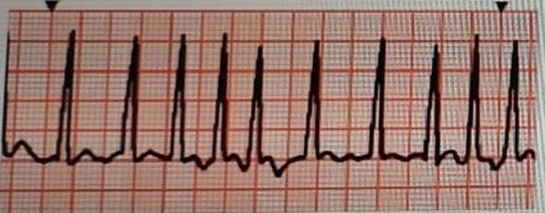Complete the following sentence from the list of options
Monitor

The nurse is caring for a client who is admitted to the telemetry unit with a new onset of the following rhythm. The nurse assesses the rhythm as
The Correct Answer is {"dropdown-group-1":"C","dropdown-group-2":"D","dropdown-group-3":"D"}
Atrial fibrillation: This is a common arrhythmia where the atria quiver instead of contracting normally, leading to irregular heart rhythms.
Amiodarone- an antiarrhythmic medication may be used to control the heart rate or rhythm in atrial fibrillation.
Heparin-an anticoagulant prevent thromboembolic events, such as stroke, anticoagulants like heparin, enoxaparin, or newer agents like rivaroxaban are used.
Nursing Test Bank
Naxlex Comprehensive Predictor Exams
Related Questions
Correct Answer is A
Explanation
A. INR = 3.7: The International Normalized Ratio (INR) is a measure of blood clotting. An INR greater than
3.0 indicates that the blood is not clotting properly, which can be caused by warfarin overdose. An elevated INR requires FFP to correct coagulopathy.
B. Hemoglobin = 6.3g/dL: This is low, indicating anemia, but it is not directly related to warfarin overdose. The primary issue here is coagulopathy, not anemia.
C. Fibrinogen = 90mg/dL: Fibrinogen levels may be decreased in various conditions, but this alone does not necessarily require additional FFP unless it’s below a critical threshold. Fibrinogen is not the main marker for warfarin overdose.
D. Platelets = 101,000 mm3: This platelet count is within the lower end of the normal range but does not indicate that more FFP is needed in response to warfarin overdose.
Correct Answer is ["A","C","D"]
Explanation
A. Increased respiratory rate - Fluid overload can lead to pulmonary edema, which causes difficulty breathing and an increased respiratory rate.
B. Increased temperature - Fluid overload does not typically cause a temperature increase. A fever may indicate infection rather than fluid overload.
C. Increased heart rate - The body compensates for fluid overload by increasing the heart rate to maintain cardiac output.
D. Increased blood pressure - Fluid overload leads to increased blood volume, which results in elevated blood pressure.
E. Increase hematocrit - Hematocrit usually decreases with fluid overload, as it is diluted by the extra fluid volume.
Whether you are a student looking to ace your exams or a practicing nurse seeking to enhance your expertise , our nursing education contents will empower you with the confidence and competence to make a difference in the lives of patients and become a respected leader in the healthcare field.
Visit Naxlex, invest in your future and unlock endless possibilities with our unparalleled nursing education contents today
Report Wrong Answer on the Current Question
Do you disagree with the answer? If yes, what is your expected answer? Explain.
Kindly be descriptive with the issue you are facing.
